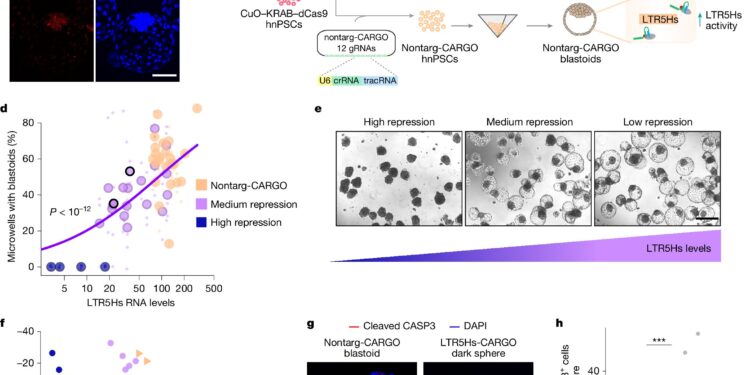The LTR5HS activity contributes to the training potential for HNPSC blastoids. Credit: Nature (2025). DOI: 10.1038 / S41586-025-09571-1
Our ancient past is not always buried history. Regarding our DNA, almost 9% of the human genome consists of remains of genetic material from old viruses (called endogenous or towards retrovirus) which infected our ancestors millions of years ago and were permanently integrated into our genetic code. In a new study published in the journal NatureScientists have shown that a single piece of this viral jack is essential for the early stages of human life.
Knowledge of how orv affects human development is limited because scientists obviously cannot conduct ethical experiences on embryos. To overcome this, the researchers of this study used human blastoids, 3D models cultivated from stem cells that imitate the structure and types of key cells of a natural blastocyst. This is the ball of cells that form at the start of pregnancy, about five to seven days after fertilization.
Test the role of viral DNA
The team focused on a specific type of ERV known as Hervk LTR5HS, which was introduced into our DNA after our line separates from the old world monkeys. Although this event occurred millions of years ago, it is considered relatively recent in evolutionary genetic terms.
To determine the functional effect of these viral remains on the early embryo, the research team used cutting -edge genetic tools which act as molecular scissors to extinguish the LTR5HS elements or delete them completely. The results were spectacular. The blastoids have died or have transformed into disorganized tufts. This has provided clear evidence that this old DNA is essential for the prior stage of human development.
The researchers also dug more deeply to discover what was going on at the subcellular level. They discovered that the LTR5HS elements act as powerful improvements, strengthening the activity of neighboring genes. When their activity is deleted, many genes nearby associated with the epiblast (the cell layer which ends up forming the embryo) are refused. That is to say that their activity is reduced. This has shown that viral DNA is directly responsible for the control of these essential early development instructions.
One of the most important discoveries concerned the ZNF729 gene. The team noted that a specific LTR5HS insertion (an additional piece of DNA added to a DNA sequence), unique to humans, acts as a main key to activate this gene. Since the gene regulates fundamental cellular processes, such as cell growth and metabolism, the main key to viral DNA is crucial for our development.
As the main author Joanna Wysocka said, “our results illustrate how recently emerging transposable elements and genes can confer essential functions on development in humans.”
Written for you by our author Paul Arnold, published by Gaby Clark, and verified and revised by Robert Egan – This article is the result of meticulous human work. We are counting on readers like you to keep independent scientific journalism alive. If this report matters to you, please consider a donation (especially monthly). You will get a without advertising count as a thank you.
More information:
Raquel Fueyo et al, a regulatory mechanism specific to humans revealed in a pre-implantation model, Nature (2025). DOI: 10.1038 / S41586-025-09571-1
© 2025 Science X Network
Quote: Ancient viral DNA is essential to the development of human embryos, shows the study (2025, October 2) recovered on October 2, 2025 from
This document is subject to copyright. In addition to any fair program for private or research purposes, no part can be reproduced without written authorization. The content is provided only for information purposes.


